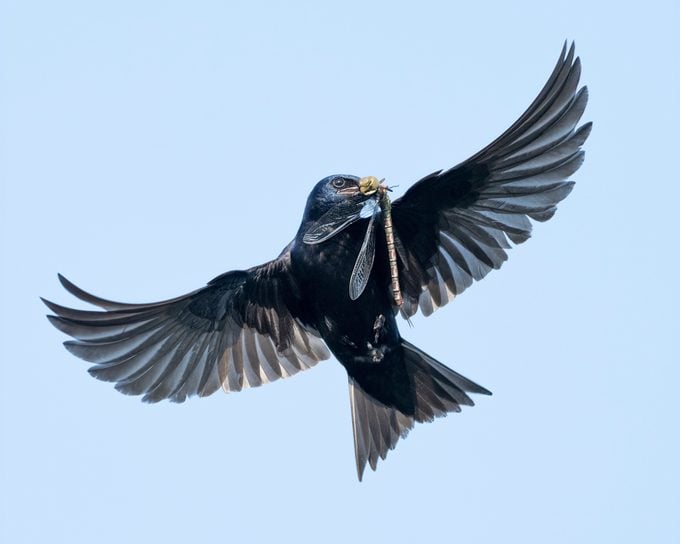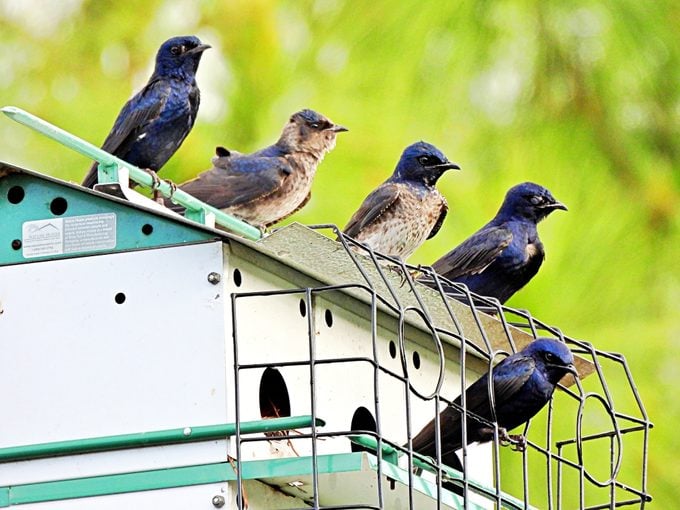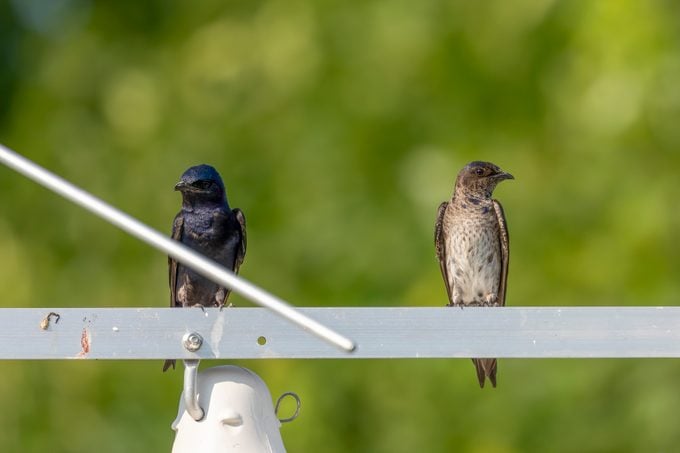Do Purple Martins Eat Mosquitoes?
Updated: Aug. 25, 2022
Do purple martins really eat thousands of mosquitoes a day? We checked with an expert to find out. Plus, learn about why you want martins in your yard.

It’s a commonly brandished statistic: “Purple martins eat 2,000 mosquitoes a day!” We admit, it sounds lovely. Who wouldn’t want a bird in their backyard that’s a mosquito-eating machine? But given all the hullaballoo about purple martins and those nasty, buzzy insects, we felt the need to dig deeper. Do purple martins eat mosquitoes? We asked an expert, and here’s what we found out.
Learn which birds are known for eating insects.
Do Purple Martins Eat Mosquitoes?

Robyn Bailey, project leader at Cornell Lab of Ornithology’s NestWatch, sets the record straight for us: purple martins do not, in fact, regularly eat mosquitoes. There are several reasons that stat is wrong. As she points out, purple martins are out hunting for food during the day, while mosquitoes emerge during the evening. There isn’t much overlap in their schedules, and it certainly isn’t enough for the birds to eat thousands of them!
Psst—we found 8 mosquito-repelling plants you need in your backyard ASAP.
Furthermore, purple martins are looking for food in places other than where mosquitoes lurk. “Purple martins are feeding up high in the sky, out in the open,” Robyn explains. “Mosquitoes are closer to the ground, where their prey species live.”
If they’re not eating mosquitoes, what do they eat? Robyn says one Oklahoma study found purple martins eat invasive red fire ants, a notorious pest in the South and Midwest. She says they also eat termites and beetles, things people wouldn’t want in their homes, in addition to dragonflies, damselflies and other insects.
These are the 8 types of swallow birds you should know.
Fantastic! you think. If I can attract purple martins to my yard, I’ll never have a termite or invasive red fire ant problem. Not so fast. Robyn points out that while purple martins can eat bad bugs, it’s highly unlikely that their presence would eliminate a problem or prevent one from occurring. “They’re not specializing on those things,” she says, “so that’s not to say if you put up a purple martin colony, you’ll suddenly have no pests in your yard.”
Do hummingbirds eat mosquitoes? Here’s what you should know.
Benefits of Attracting Purple Martins

With all that said, there’s still good reason to want purple martins around. Robyn notes that the population is in decline, so any efforts to help are meaningful. “Having them in your yard would be of benefit to the bird,” she explains. “If you’re interested in helping species in conservation decline in your region, you can accomplish that by attracting purple martins.”
As Robyn also mentions, they’re beautiful birds. And if you can invite them to nest in your yard by putting up a purple martin house or a gourd array, you just might be the envy of all your birder friends. “They’re a bit of work [to attract], which is why I said it’s a bit of a ‘status’ thing to say you have purple martins!” she laughs.
Keep in mind that these swallows like to nest in open areas near water, so if you live somewhere that doesn’t feature those things, you might not be able to bring them in. But there are plenty of other birds you can invite to nest in your yard, like tree swallows, bluebirds, robins, wrens and chickadees. And no matter whether they’re nesting in your yard or swooping over a lake, there’s always cause to admire purple martins.
Next, learn how to turn a gourd into a birdhouse.




















